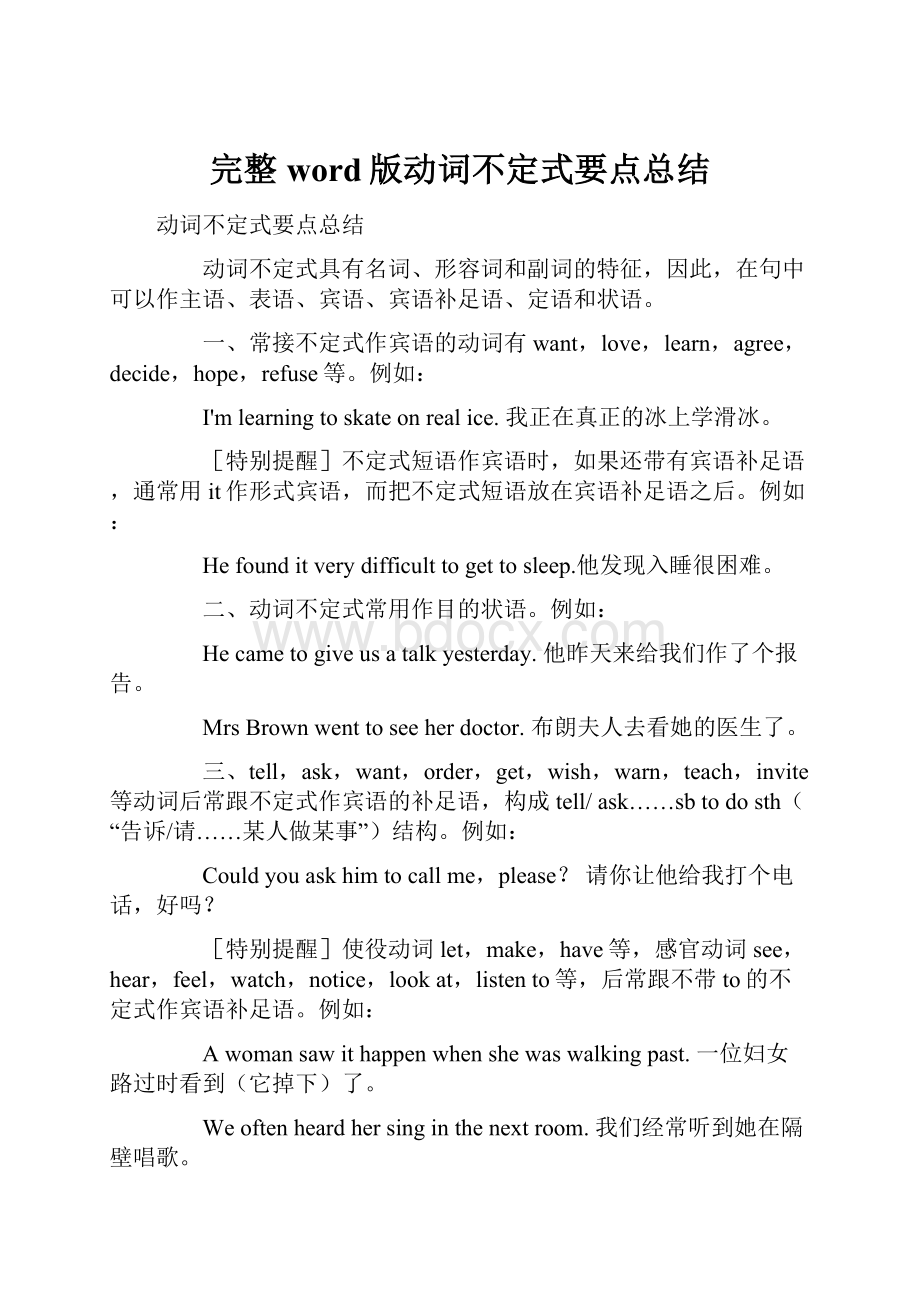完整word版动词不定式要点总结.docx
《完整word版动词不定式要点总结.docx》由会员分享,可在线阅读,更多相关《完整word版动词不定式要点总结.docx(19页珍藏版)》请在冰豆网上搜索。

完整word版动词不定式要点总结
动词不定式要点总结
动词不定式具有名词、形容词和副词的特征,因此,在句中可以作主语、表语、宾语、宾语补足语、定语和状语。
一、常接不定式作宾语的动词有want,love,learn,agree,decide,hope,refuse等。
例如:
I'mlearningtoskateonrealice.我正在真正的冰上学滑冰。
[特别提醒]不定式短语作宾语时,如果还带有宾语补足语,通常用it作形式宾语,而把不定式短语放在宾语补足语之后。
例如:
Hefounditverydifficulttogettosleep.他发现入睡很困难。
二、动词不定式常用作目的状语。
例如:
Hecametogiveusatalkyesterday.他昨天来给我们作了个报告。
MrsBrownwenttoseeherdoctor.布朗夫人去看她的医生了。
三、tell,ask,want,order,get,wish,warn,teach,invite等动词后常跟不定式作宾语的补足语,构成tell/ask……sbtodosth(“告诉/请……某人做某事”)结构。
例如:
Couldyouaskhimtocallme,please?
请你让他给我打个电话,好吗?
[特别提醒]使役动词let,make,have等,感官动词see,hear,feel,watch,notice,lookat,listento等,后常跟不带to的不定式作宾语补足语。
例如:
Awomansawithappenwhenshewaswalkingpast.一位妇女路过时看到(它掉下)了。
Weoftenheardhersinginthenextroom.我们经常听到她在隔壁唱歌。
注意:
在被动语态句子中,不定式前必须加to.例如:
Hewasmadetodoit.他被迫做这件事。
Shewasoftenheardtosinginthenextroom.经常听到她在隔壁唱歌。
四、不定式短语作定语要放在被修饰的词语之后。
例如:
Ihavealotofworktodo.我有许多事情要做。
五、不定式短语作主语时,常用it作形式主语,真正的主语不定式短语放在后面。
例如:
Itisrighttogiveupsmoking.戒烟是有益的。
六、作表语。
例如:
Tohim,thefirstimportantthingwastosavelives.对他来说,最重要的事情就是拯救生命。
Hiswishistobecomeascientist.他的愿望是当一名科学家。
七、动词不定式用在疑问词how,when,where,what,which等之后,作宾语或宾语补足语。
例如:
Hetaughtushowtouseacomputer.他教我们如何使用计算机。
Idon'tknowwheretogo?
我不知道去哪里。
1)动词+不定式
afford,aim,appear,agree,arrange,ask,be,decide,bother,care,choose,come,dare,demand,desire,determine,expect,elect,endeavor,hope,fail,happen,help,hesitate,learn,long,mean,manage,offer,ought,plan,prepare,pretend,promise,refuse,seem,tend,wait,wish,undertake
Thedriverfailedtoseetheothercarintime.
司机没能及时看见另一辆车。
Ihappentoknowtheanswertoyourquestion.
我碰巧知道你那道问题的答案。
2)动词+不定式;动词+宾语+不定式
ask,beg,choose,expect,hate,helpintendlike,love,needprefer,prepare,promise,want,wish
Iliketokeepeverythingtidy. 我喜欢每件东西都保持整洁。
Ilikeyoutokeepeverythingtidy. 我喜欢你使每件东西都保持整洁。
IwanttospeaktoTom. 我想和汤姆谈话。
IwantyoutospeaktoTom. 我想让你和汤姆谈话。
3)动词+疑问词+to
decide,know,considerforget,learn,remember,show,understand,see,wonder,hear,findout,explain,tell
Pleaseshowushowtodothat.请演示给我们如何去做。
Therearesomanykindsoftape-recordersonsalethatIcan'tmakeupmymindwhichtobuy.有这么多的录音机,我都拿不定主意买哪一种。
注意:
疑问词带不定式在句中作成分时,谓语动词用单数。
如:
Thequestionishowtoputitintopractice.问题是怎样把它付诸实施。
2.不定式作补语
1)动词+宾语+不定式(todo)
advise,allow,appoint,believe,cause,challenge,command,compel,consider,declare,drive,enable,encourage,find,forbid,force,guess,hire,imagine,impel,induce,inform,instruct,invite,judge,know,like,order,permit,persuade,remind,report,request,require,select,send,state,suppose,tell,think,train,trust,understand,urge,warn
a.Fatherwillnotallowustoplayonthestreet. 父亲不让我们在街上玩耍。
b.Webelievehimtobeguilty.我们相信他是有罪的。
Find的特殊用法
Find后可用分词做宾补,或先加形式宾语,再加形容词,最后加带to的动词不定式。
find后也可带一个从句。
此类动词还有get,have。
Ifoundhimlyingontheground.
Ifounditimportanttolearn.
IfoundthattolearnEnglishisimportant.
典型例题Thenextmorningshefoundtheman___inbed,dead.
A.lying B.lie C.lay D.laying
答案:
A.find的宾语后面,用分词或分词短语,起宾语补足语作用。
现在分词表达主动,也表达正在进行,过去分词表达被动。
2)to+be的不定式结构,作补语的动词。
acknowledge,believe,consider,think,declare(声称),discover,fancy(设想),feel,find, guess,judge,imagine,know,prove,see(理解),show,suppose,take(以为),understand
WeconsiderTomtobeoneofthebeststudentsinourclass.我们认为汤姆是班上最好的学生之一。
典型例题
CharlesBabbageisgenerallyconsidered ___thefirstcomputer.
A.toinvent B.inventing C.tohaveinvented D.havinginvented
答案:
A.由considertodosth.排除B、D。
.此句只说明发明这一个事实,不定式后用原形即可。
而C为现在完成时,发明为点动词一般不用完成时,且此处也不强调对现在的影响,因此不选C。
3)tobe+形容词
seem,appear,besaid,besupposed,bebelieved,bethought,beknown,bereported,hope,wish,desire,want,plan,expect,mean
Thebookisbelievedtobeuninteresting. 人们认为这本书没什么意思。
4)therebe+不定式
believe,expect,intend,like,love,mean,prefer,want,wish,undrstand
Wedidn'texpecttheretobesomanypeoplethere.我们没料到会有那么多人在哪里。
注意:
有些动词需用as短语做补语,如regard,thinkbelieve,take,consider.
WeregardTomasourbestteacher. 我们认为汤姆是我们最好的老师。
Marytookhimasherfather. 玛丽把他当作自己的父亲。
3.不定式作主语
1)It'seasy(forme)todothat.我做这事太容易了。
easy,difficult,hard,important,possible,impossible,comfortable,necessary,better;
thefirst,thenext,thelast,thebest,toomuch,toolittle,notenough
It'ssonicetohearyourvoice. 听到你的声音真高兴。
It'snecessaryforyoutolockthecarwhenyoudonotuseit.当你不用车的时候,锁车是有必要的。
2)It'sverykindofyoutohelpus.他帮助我们,他真好。
kind,nice,stupid,rude,clever,foolish,thoughtful,thoughtless,brave,considerate(考虑周到的),silly,selfish(自私的)
Itwassillyofustobelievehim. 我们真愚蠢,竟然相信了他。
Itseemedselfishofhimnottogivethemanything. 他不给他们任何东西,这显得太自私了。
注意1)其他系动词如,look,appear等也可用于此句型
2)不定式作为句子成分时,动词用单数形式。
3)当不定式作主语的句子中又有一个不定式作表语时,不能用Itis…to…的句型
(对)Toseeistobelieve. 百闻不如一见。
(错)Itistobelievetosee.
It'sforsb.和It'sofsb.
1)forsb.常用于表示事物的特征特点,表示客观形式的形容词,如easy,hard,difficult, interesting,impossible等:
It'sveryhardforhimtostudytwolanguages.对他来说学两门外语是很难的。
2)ofsb的句型一般用表示人物的性格,品德,表示主观感情或态度的形容词,如good,kind,nice,clever,foolish,right。
It'sveryniceofyoutohelpme.你来帮助我,你真是太好了。
for与of的辨别方法
用介词后面的代词作主语,用介词前边的形容词作表语,造个句子。
如果道理上通顺用of,不通则用for。
如:
Youarenice. (通顺,所以应用of)。
Heishard. (人是困难的,不通,因此应用for。
)
4.不定式作表语
不定式可放在be动词后面,形成表语。
例如:
Myworkistocleantheroomeveryday.
Hisdreamistobeadoctor.
5.不定式作定语
不定式做定语通常要放在被修饰的词后。
例如:
Ihavealotofworktodo.
Sohemadesomecandlestogivelight.
6.不定式作状语
1)目的状语
To…onlyto(仅仅为了),inorderto,soasto,so(such)…asto…(如此……以便……)
Heransofastastocatchthefirstbus. 他飞快地跑以便赶上第一班车。
Icomehereonlytosaygood-byetoyou. 我来仅仅是向你告别。
2)作结果状语,表事先没有预料到的,要放在句子后面。
WhathaveIsaidtomakeyouangry.
Hesearchedtheroomonlytofindnothing.
3)表原因I'mgladtoseeyou.
典型例题
Thechairlooksratherhard,butinfactitisverycomfortableto___.
A.sit B.siton C.beseat D.besaton
答案:
B. 如果不定式为不及物动词,其后应有必要的介词。
当动词与介词连用时,常位于"形容词+动词不定式"结构的末尾。
用作介词的to
to有两种用法:
一为不定式+动词原形;一为介词+名词/动名词,to在下面的用法中是第二种,即to+名词/动名词:
admitto承认,confessto承认,beaccustomedto习惯于,beusedto习惯于,stickto坚持,turnto开始,着手于,devoteoneselfto献身于,bedevotedto致力于,lookforwardto盼望,payattentionto
注意省to的动词不定式
1)情态动词(除ought外,oughtto):
2)使役动词let,have,make:
3)感官动词see,watch,lookat,notice,observe,hear,listento,smell,feel,find等后作宾补,省略to。
注意在被动语态中则to不能省掉。
Isawhimdance.=Hewasseentodance.
Thebossmadethemworkthewholenight.=Theyweremadetoworkthewholenight.
4)wouldrather,hadbetter:
5)Why…/whynot…:
6)help可带to,也可不带to,helpsb(to)dosth:
7)but和except:
but前是动词do时,后面出现的动词用不带to的动词不定式。
8)由and,or和than连接的两个不定式,第二个to可以省去:
9)通常在discover,imagine,suppose,think,understand等词后,可以省去tobe:
Heissupposed(tobe)nice. 他应该是个好人。
举例:
HewantstomovetoFranceandmarrythegirl.Hewantstodonothingbutgoout.比较:
Hewantstodonothingbutgoout.Hewantstobelieveanythingbuttotakethemedicine.
典型例题
1)----Iusuallygotherebytrain.
----Whynot___byboatforachange?
A.totrygoing B. tryingtogo C. totryandgo D. trygoing 答案:
D.whynot后面接不带to的不定式,因此选D。
2)Pauldoesn'thavetobemade___.Healwaysworkshard.
A.learn B.tolearn C.learned D.learning
答案:
B.make后接不带to的动词不定式,当其用于被动时,to不可省略。
动词不定式的否定式
Tellhimnottoshutthewindow…
ShepretendednottoseemewhenIpassedby.我走过的时候,她假装没看见。
典型例题
1)Tellhim___thewindow.
A.toshutnot B.nottoshut C.tonotshut D.notshut
答案:
B。
tellsbtodosth的否定形式为tellsbnottodosth.
2) Shepretended___mewhenIpassedby.
A. nottosee B.notseeing C.tonotsee D. havingnotseen
答案:
A。
pretend后应接不定式。
其否定形式为pretendnottodosth.。
3)Mrs.Smithwarnedherdaughter___afterdrinking.
A.nevertodrive B.toneverdriver C.neverdriving D.neverdrive答案:
A。
warnsbtodosth.的否定形式为warnsbnottodosth.此处用的是否定词never.
4)Theboywantedtoridehisbicycleinthestreet,buthismothertoldhim____.
A.notto B.nottodo C.notdoitD.donotto
答案:
A。
notto为nottodoit的省略形式。
可以只用to这个词,而不必重复整个不定式词组。
及物动词do后应有名词、代词等,否则不对,因此B,D不对。
5)Thepatientwaswarned___oilyfoodaftertheoperation.
A.toeatno B.eatingnot C.nottoeat D.noteating
答案:
C。
warn一词要求后用不定式,此处为不定式的被动,否定形式为bewarnednottodo。
不定式的特殊句型too…to…
1)too…to 太…以至于…
Heistooexcitedtospeak.他太激动了,说不出话来。
----CanIhelpyou?
需要我帮忙吗?
----Well,I'mafraidtheboxistooheavyforyoutocarryit,butthankyouallthesame. 不用了。
这箱子太重,恐怕你搬不动。
谢谢您。
2)如在too前有否定词,则整个句子用否定词表达肯定,too后那个词表达一种委婉含义,意为"不太"。
It'snevertoolatetomend. (谚语) 改过不嫌晚。
3)当too前面有only,all,but时,意思是:
非常…等于very。
I'monlytoopleasedtobeabletohelpyou.我非常高兴能帮助你。
Hewasbuttooeagertogethome.他非常想回家。
不定式的特殊句型soasto
1)表示目的;它的否定式是soasnottodo。
Tomkeptquietabouttheaccidentsoasnottolosehisjob. 汤姆对事故保持沉默是为了不丢掉他的工作。
Goinquietlysoasnottowakethebaby.轻点进去,别惊醒了婴儿。
2)sokindasto---劳驾
Wouldyoubesokindastotellmethetime?
劳驾,现在几点了。
不定式的特殊句型Whynot
"Whynot+动词原形"表达向某人提出建议,翻译为:
"为什么不…?
""干吗不…?
例如:
Whynottakeaholiday?
干吗不去度假?
不定式的时态和语态
时态\语态主动被动
一般式todotobedone
进行式tobedoing
完成式tohavedonetohavebeendone
完成进行式tohavebeendoing
1)现在时:
一般现在时表示的动词,有时与谓语动词表示的动作同时发生,有时发生在谓语动词的动作之后。
Heseemstoknowthis.
Ihopetoseeyouagain.=IhopethatI'llseeyouagain.我希望再见到你。
2)完成时:
表示的动作发生在谓语动词表示的动作之前。
I'msorrytohavegivenyousomuchtrouble.
Heseemstohavecaughtacold.
3)进行时:
表示动作正在进行,与谓语动词表示的动作同时发生。
Heseemstobeeatingsomething.
4)完成进行时:
Sheisknowntohavebeenwrea